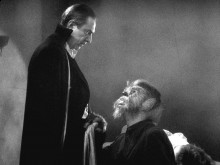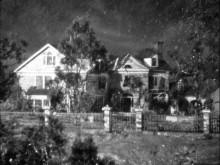Columbia isn’t a studio generally associated with horror pictures from the classic era, but they did occasionally dabble in the genre. Their most concerted effort came with the run of loosely grouped Boris Karloff “Mad Doctor” films, of which Edward Dmytryk’s The Devil Commands (1941) was the penultimate and best entry. Based on the creepy novel The Edge of Running Water by William Sloane, it’s the tale of a grief-stricken scientist (Karloff) who becomes obsessed with communicating with the spirit of his dead wife (Shirley Warde). Played for maximum spookiness (maybe a little too much so in some cases), it’s one of the most memorable of all 1940s horrors. Lew Landers’ Return of the Vampire (1944) isn’t quite in that league, but it does provide Bela Lugosi with one of his few solid movies of the decade—and one that actually gives him something to do. Surprisingly, it’s also one of only three movies where he plays a vampire.

The Devil Commands is a movie that invariably comes as a pleasant surprise for viewers only familiar with the earlier “Mad Doctor” films. Whatever the merits of The Man They Could Not Hang (1939), The Man with Nine Lives (1940) and Before I Hang (1940), they’re a bit on the tepid side in terms of horror content. As soon as The Devil Commands opens, it’s clear this is going to be an altogether different proposition with its atmospheric shot of an old dark house perched on a cliff overlooking the sea (OK, so it’s model work) with a thunderstorm raging. (The soundtrack narration is a little silly, especially when it poses the question, “Why are they afraid?” when the film is doing its damndest to sell you on just how spooky it is.)

The story has Dr. Julian Blair (Karloff) experimenting with recording brain waves—sort of a showy EEG. His last experiment prior to her death is on his wife. After her death, he turns the equipment on and her brain waves start registering again, convincing him—but, of course, no one else—that it might be possible to contact the dead with this device. Hooking up with a bogus spirit medium, Mrs. Walters (Anne Revere), who isn’t as bogus as she thinks, he moves to the old dark house from the opening to continue his experiments, incurring the ill-will of the locals, especially when graves start being robbed. Locals get kind of suspicious when newcomers and the disappearances of their dead relatives happen at just the same time.

The film departs a good bit in structure from its source novel and the vaguely lesbian cinematic Mrs. Walters owes more to Judith Anderson’s Mrs. Danvers from Rebecca (1940) than to the book. But the concept remains unchanged. It’s not a big production—mostly a classy B picture—but it’s a surprisingly convincing one in both atmosphere and effects (the vortex that appears during the experiments is wonderfully achieved). Few things in 1940s horror are as creepy as the “seances” involving Mrs. Walters and a circle of corpses outfitted in the brain wave “helmets.” It may be a minor classic of the genre, but it is a classic.

Return of the Vampire, on the other hand, is pretty much a straightforward—almost by-the-numbers—vampire movie, and one that stays on something like a high school level of horror. In many respects, it seems to prefigure the Hammer horrors of the late 1950s and early 1960s, but it also has much of the feel of 1940s Universal horror. What’s surprising is that there really aren’t that many straightforward vampire movies from this era—just like it’s surprising that this is only the second time that Bela Lugosi, the actor most associated with Dracula and vampires, played an honest-to-Stoker blood sucker. In fact, his Armand Tesla really is Count Dracula in everything but name. (Whether or not they really did, Universal felt they owned the name.)
In its favor, the production values are pretty solid, even if its fog-shrouded cemetery is a little cramped and very obviously on a soundstage. The latter’s not necessarily a bad thing, though, and adds to the film’s unreal, fairy tale quality. Plus, there’s Lugosi in fine form as Tesla—and that’s a huge plus. The only downside comes from the screenplay, which does the unthinkable by not giving him any truly memorable dialogue. I’ve seen the movie probably 15 times over the years and can’t remember a single line, yet I can quote tons of lines from Lugosi’s trashy Bs from the same era. Like everything else about the movie, there’s a feel of the perfunctory about the dialogue.

The film’s great inspiration seems to have been to give Tesla a werewolf sidekick named Andreas (Matt Willis). It’s not a bad werewolf (the make-up was re-used in a Three Stooges short), apart from that cute little doggie nose, but the idea of a talking—downright chatty—werewolf doesn’t do much for the fright factor. Worse, the teeth make it hard for Willis to talk and he frankly sounds like he’s doing some kind of Amos ‘n’ Andy impression. I can’t think that’s what they were going for. The character, however, does finally make it clear just how vampires manage to remain fresh and cripsly-dressed for hundreds of years, since Andreas apparently tends to his master’s laundry. I like it when these movies turn educational.



Per your review, Ken, I revisited THE DEVIL COMMANDS last evening. It does hold up extremely well and has some wonderful moments of creepiness. (Of course, the scariest part would be when Blair gets his electric bill!)
Karloff is always sympathetic, largely through omission. By keeping his dirty work off-screen -– i.e., by not showing him digging up graves and plugging electrodes into corpses — Dmytryk keeps Blair’s madness at a safe distance. It also lessens the horrors to some extent, but not fatally. Using his daughter to complete the experiment is a pretty schmucky thing to do.
Given Blair’s academically inspired forgetfulness and reliance on electricity early on, it might have been a nice touch if the big finale showed astral Mrs. Blair (if that is indeed who is calling for “Julian”) nagging him about unplugging the toaster or some other small appliance.
Of course, it might have been even more frightening if it was implied that he hadn’t reached his wife –- but instead something else…..
At any rate, I need to seek out the book.
Of course, it might have been even more frightening if it was implied that he hadn’t reached his wife –- but instead something else…..
By the time the Brit censor got through with it in 1941, he hadn’t reached anyone or anything.
At any rate, I need to seek out the book.
I haven’t read it in a number of years (I still have the 60 cent Bantam paperback I bought in high school), but it’s worth seeking out.
Lugosi actually played a vampire in five movies if you count ABBOTT & COSTELLO MEET FRANKENSTEIN and OLD MOTHER REILLY MEETS THE VAMPIRE along with DRACULA, MARK OF THE VAMPIRE, and RETURN.
Lugosi actually played a vampire in five movies if you count ABBOTT & COSTELLO MEET FRANKENSTEIN and OLD MOTHER REILLY MEETS THE VAMPIRE along with DRACULA, MARK OF THE VAMPIRE, and RETURN.
No, he didn’t. He’s an actor impersonating a vampire in Mark of the Vampire, and it’s made clear in Old Mother Riley that he’s a madman who thinks he’s a vampire.